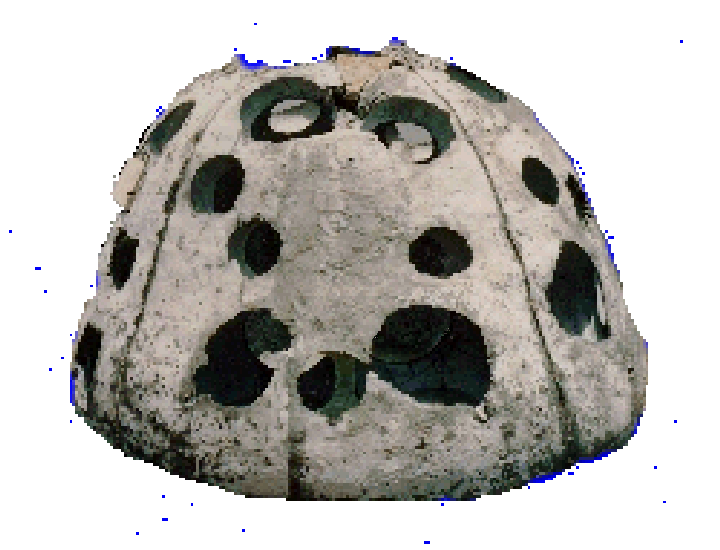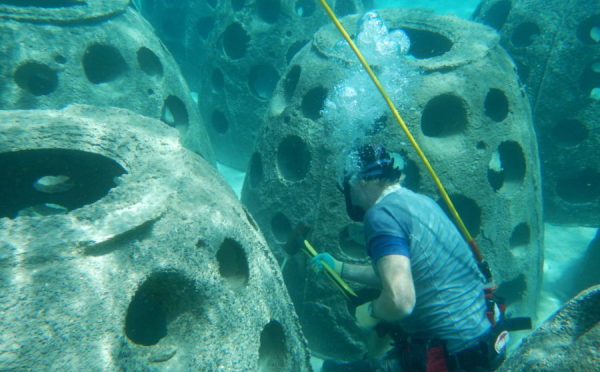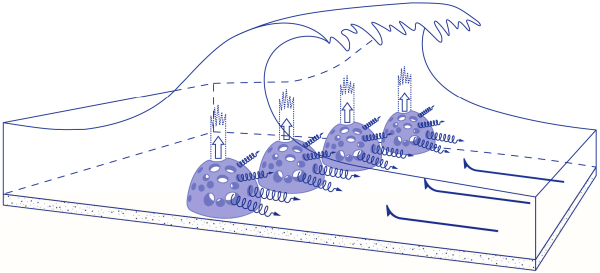

Reef Beach
Shoreline Restoration
Shoreline Restoration
Desktop Analysis
Reef Beach assists coastal engineers in designing Reef Ball submerged breakwaters.


Before you permit or design, let us preform a free desktop analysis of your project
Reef Beach provides clients and their engineers with a courtesy desktop analysis to determine early on if Reef Balls should be included or excluded as a considered option. As the client's coastal engineer you may already have information that helps in this analysis. We usually like to meet with you during our initial site survey work both before we get into the water and after we complete the survey so we can coordinate with you as you take the preliminary site design and do your own work to finalize it into a permitable and client suited project. We don't suggest you gather any of this data as an extra expense but send us what you already have for the desktop analysis. If it passes this go/no go process then we can decide together at the site survey which of the data is missing and determine if it must be collected. Bolded items are often not collected by coastal engineers routinely so ask us if you need help in computing them. Italic items are most important.
Project location (Google Earth Mark) and typical marine fouling community description (for example coral reef, oysters/algae/barnacles, kelp)
Tide Data (annual and monthly) MHHW, MLLW, MHW, MLW, MW, AND Biological tide reference to MLW
Wave Climate Data (average, 10, 20, 50-year storm, etc., periods and heights)
Sand Transport Data (prevailing direction, volumes, seasonal changes, sources, and sinks)
Sand Grain Size Distribution Data
Water Quality Measures (turbidity, salinity, nitrates/nitrite/ammonia levels, etc.)
Aerial Photographs (historical and current) [often available on Google Earth]
Site History (storm impacts, developments, special influences)
Bathymetry (as detailed as possible, especially in project areas)
Bottom Survey (physical such as bottom type, depth to a firm substrate and biological such as corals, seagrasses, reefs, fish present at or near the project)
Permit Records (information of current or previous permits for the project)
Engineering Drawings (Autocads, drawings, or other construction plans)
List of Project Goals (for example desired beach width, desired swimming area, etc.)
Project Budget Expectations (basic range of expenditures expected to spend for desired erosion outcome)
List of Contacts (Names, emails, contact information for people involved in the project such as permitting agencies, architects, engineering firms, client decision-makers, etc.)
WHAT WILL MY RESULTS LOOK LIKE?
You will get an email that looks something like this which is based on a real review done in 2020 with the resort name and location removed. The details in your email will vary based on the information you submitted for review and any prior discussions you have had with us with your specific areas of concern.
Here are the results of your Desktop Analysis for EXAMPLE 1:" ACME" BEACH RESORT
You have a PASSING overall score, with some areas of concern.
Tide Range: PASS : Tide Range is minimum in this area and monthly and annually fluctuations are on average less than .2 meters
Biological Tide Line : SET AT -.2 (minimum water height)
Depth Profile: PASS : It will require custom fitting with multiple Reef Balls sizes, especially near the shallow outcroppings. Most likely would need 3-5 rows of Reef Balls from Goliath to Pallet Balls sizes determined by best fit to seafloor features within design parameters.
Biological Suitability: NEEDS SURVEY: Aerial indicates dark patches in likely build zones, need to determine if they are rocky, grassy, or other characteristics.
Human Use: PASS: Hotel property where guest would benefit from recreational and aesthetics provided by Reef Balls over geotubes & engineered structures
Wave Climate: PASS: Waves are manageable but anchoring may be required based on bottom survey results
Sand Transport: FAIL: From initial observations, this site does not appear to have good sand transport and beach may require some fill depending upon client beach needs.
Bottom SurveyAnchoring Suitability: UNKNOWN: Bottom Survey needs to be completed or submitted for determination
Longshore Transport Disturbances: CAUTION ADVISED: There are natural and manmade groin like features in the project area since this project has a FAIL score for sand transport these features are not detrimental to the project but could affect erosional events independently from the protection of the Reef Ball submerged breakwater. Currents could be modeled with various seasonal wave patterns by coastal engineers to better determine if that impact would be significant.
Coral Planting Suitability: FAIL: Project is not located in a Tropical Coral Reef Zone, coral planting opportunities would likely be very limited with the exception of colder water tolerating coral, soft coral or other local marine fouling species.
Project Budget: UNKNOWN: Unable to determine if the project budget meets project requirements but large luxury resorts usually present with sufficient economics to be within reasonable budget expectations.
Project Costs: UNKNOWN: Local Concrete and labor costs unknown but presumed reasonable given the location.
Project Logistics: PASS: Not located on isolated island and city with a port located within 10 nautical miles. Local construction likely possible.
Permitting Possible: UNKNOWN: Local Authorized Contractor is familiar with local permitting requirements
RECOMMENDED ADDITIONAL INFO
Beach Renourishment Costs for initial fill to the desired width (if the client wants more than currently on-site).
Bottom Survey (both biological and bottom type)
Longshore Sand Transport Data (if the client believes we are wrong on our initial assumption there is low longshore transport)
Here are the results of your Desktop Analysis for EXAMPLE 2: "Acme" Pocket Beach
PASS
Tide Range: PASS : Tide Range is minimum in this area both monthly and annually
Biological Tide Line : SET AT -.2 (minimum water height)
Depth Profile: PASS : One size of Reef Ball can be used at the desired distance contour line. The survey is not very accurate in close to the site but it will probably require smaller sized Reef Balls such as Bay Balls & Pallet Balls.
Biological Suitability: NEEDS SURVEY: Aerial indicates dark patches that is likely submerged aquatic vegetation as close to 25 meters from the beach on the East end of the project and 40-45 meters on the west end. Building just inside the dark zone would be best but may provide a limited swim area. These areas appear to be stable since at least 2006 so probably should not be disturbed. A biological bottom survey could determine if there is a possibility to build within the dark zones without damage to the native vegetation. NOTE: There are some breaks in the dark lines about 100-125 meters offshore it is possible this would be a better location but bottom survey and depth in that area need to be determined if that area is selected large Reef Ball sizes would likely be required.
Human Use: PASS: Appears to be a cottage type resort with heavy beach use.
Wave Climate: PASS: Waves are manageable but anchoring may be required based on bottom survey results especially since smaller sized Reef Balls will likely be required.
Sand Transport: PASS: From initial observations, this site appears to have good beach sand availability in a "pocket beach" configuration. The site is in the "middle" of the pocket were submerged breakwaters perform best.
Bottom SurveyAnchoring Suitability: UNKNOWN: Bottom Survey needs to be completed or submitted for determination. Likely just sandy.
Longshore Transport Disturbances: PASS: There is a dock or pier structure, it is probably not an issue as it seems to be porous but the breakwater must be designed to accommodate it.
Coral Planting Suitability: FAIL: Project is not located in a Tropical Coral Reef Zone, coral planting opportunities would likely be very limited with the exception of colder water tolerating coral, soft coral or other local marine fouling species.
Project Budget: UNKNOWN: Unable to determine if the project budget meets project requirements but large luxury resorts usually present with sufficient economics to be within reasonable budget expectations.
Project Costs: UNKNOWN: Local Concrete and labor costs unknown but presumed reasonable given the location.
Project Logistics: PASS: Not located on isolated island and city in the area. Local construction likely possible.
Permitting Possible: UNKNOWN: Local Authorized Contractor is familiar with local permitting requirements
RECOMMENDED ADDITIONAL INFO
Bottom Survey (both biological and bottom type)